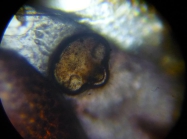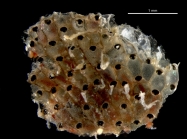WoRMS taxon details
Watersipora subtorquata (d'Orbigny, 1852)
111592 (urn:lsid:marinespecies.org:taxname:111592)
accepted
Species
Cellepora subtorquata d'Orbigny, 1852 · unaccepted (Basionym)
Escharina torquata d'Orbigny, 1842 · unaccepted (Subsequent homonym)
Watersipora edmondsoni Soule & Soule, 1968 · unaccepted
marine, brackish, fresh, terrestrial
recent + fossil
Not documented
Distribution Israel: otherwise Indo-West Pacific
Distribution Israel: otherwise Indo-West Pacific [details]
Bock, P. (2025). World List of Bryozoa. Watersipora subtorquata (d'Orbigny, 1852). Accessed through: World Register of Marine Species at: https://www.marinespecies.org/aphia.php?p=taxdetails&id=111592 on 2025-04-04
Date
action
by
![]() The webpage text is licensed under a Creative Commons
Attribution 4.0 License
The webpage text is licensed under a Creative Commons
Attribution 4.0 License
Nomenclature
original description
(of Watersipora edmondsoni Soule & Soule, 1968) Soule, D. F.; Soule, J. D. (1968). Bryozoan fouling organisms from Oahu, Hawaii, with a new species of Watersipora. <em>Bulletin of the Southern California Academy of Science.</em> 67: 203-218. [details]
original description (of Escharina torquata d'Orbigny, 1842) Orbigny, A. D. d'. (1841-1847). Voyage dans l'Amérique Méridionale (le Brésil, la république orientale de l'Uruguay, la République argentine, la Patagonie, la république du Chili, la république de Bolivia, la république du Pérou), exécuté pendant les années 1826, 1827, 1828, 1829, 1830, 1831, 1832, et 1833. Volume 5 (4). Zoophytes, pp. 17-28 [1847], pl. 1, 3, 5 [1841], 2, 4, 6-13 [1842]. P. Bertrand, Paris, and Levrault, Strasbourg. <em>P. Bertrand, Paris; V. Levrault, Strasbourg.</em> Text: 1847: 7-28; Plates: 1841: 1, 3, 5; 1842: 2, 4, 6-13., available online at http://biodiversitylibrary.org/page/14544007
page(s): Plate 4, Figure 1-4 [details]
basis of record Hayward, P.J. (2001). Bryozoa, <B><I>in</I></B>: Costello, M.J. <i>et al.</i> (Ed.) (2001). <i>European register of marine species: a check-list of the marine species in Europe and a bibliography of guides to their identification. Collection Patrimoines Naturels,</i> 50: pp. 325-333 (look up in IMIS) [details]
original description (of Escharina torquata d'Orbigny, 1842) Orbigny, A. D. d'. (1841-1847). Voyage dans l'Amérique Méridionale (le Brésil, la république orientale de l'Uruguay, la République argentine, la Patagonie, la république du Chili, la république de Bolivia, la république du Pérou), exécuté pendant les années 1826, 1827, 1828, 1829, 1830, 1831, 1832, et 1833. Volume 5 (4). Zoophytes, pp. 17-28 [1847], pl. 1, 3, 5 [1841], 2, 4, 6-13 [1842]. P. Bertrand, Paris, and Levrault, Strasbourg. <em>P. Bertrand, Paris; V. Levrault, Strasbourg.</em> Text: 1847: 7-28; Plates: 1841: 1, 3, 5; 1842: 2, 4, 6-13., available online at http://biodiversitylibrary.org/page/14544007
page(s): Plate 4, Figure 1-4 [details]
basis of record Hayward, P.J. (2001). Bryozoa, <B><I>in</I></B>: Costello, M.J. <i>et al.</i> (Ed.) (2001). <i>European register of marine species: a check-list of the marine species in Europe and a bibliography of guides to their identification. Collection Patrimoines Naturels,</i> 50: pp. 325-333 (look up in IMIS) [details]
Other
context source (Introduced species)
Katsanevakis, S.; Bogucarskis, K.; Gatto, F.; Vandekerkhove, J.; Deriu, I.; Cardoso A.S. (2012). Building the European Alien Species Information Network (EASIN): a novel approach for the exploration of distributed alien species data. <em>BioInvasions Records.</em> 1: 235-245., available online at http://easin.jrc.ec.europa.eu [details] Available for editors  [request]
[request]
additional source Gordon, D. P.; Taylor, P. D.; Bigey, F. P. (2009). Phylum Bryozoa: moss animals, sea mats, lace corals. <em>in: Gordon, D.P. (Ed.) (2009). New Zealand inventory of biodiversity: 1. Kingdom Animalia: Radiata, Lophotrochozoa, Deuterostomia.</em> pp. 271-297. [details]
additional source Winston, J. E. and F. J. Maturo Jr. 2009. Bryozoans (Ectoprocta) of the Gulf of Mexico, Pp. 1147–1164 in Felder, D.L. and D.K. Camp (eds.), Gulf of Mexico–Origins, Waters, and Biota. Biodiversity. Texas A&M Press, College Station, Texas. [details]
additional source Liu, J.Y. [Ruiyu] (ed.). (2008). Checklist of marine biota of China seas. <em>China Science Press.</em> 1267 pp. (look up in IMIS) [details] Available for editors [request]
[request]
biology source Tepolt, C. K. (2014). Adaptation in marine invasion: a genetic perspective. <em>Biological Invasions.</em> 17(3): 887-903., available online at https://doi.org/10.1007/s10530-014-0825-8
note: Here, I review evidence for adaptation in marine invasion, considering both quantitative and genetic studies. [details] Available for editors [request]
[request]
additional source Gordon, D. P.; Taylor, P. D.; Bigey, F. P. (2009). Phylum Bryozoa: moss animals, sea mats, lace corals. <em>in: Gordon, D.P. (Ed.) (2009). New Zealand inventory of biodiversity: 1. Kingdom Animalia: Radiata, Lophotrochozoa, Deuterostomia.</em> pp. 271-297. [details]
additional source Winston, J. E. and F. J. Maturo Jr. 2009. Bryozoans (Ectoprocta) of the Gulf of Mexico, Pp. 1147–1164 in Felder, D.L. and D.K. Camp (eds.), Gulf of Mexico–Origins, Waters, and Biota. Biodiversity. Texas A&M Press, College Station, Texas. [details]
additional source Liu, J.Y. [Ruiyu] (ed.). (2008). Checklist of marine biota of China seas. <em>China Science Press.</em> 1267 pp. (look up in IMIS) [details] Available for editors
biology source Tepolt, C. K. (2014). Adaptation in marine invasion: a genetic perspective. <em>Biological Invasions.</em> 17(3): 887-903., available online at https://doi.org/10.1007/s10530-014-0825-8
note: Here, I review evidence for adaptation in marine invasion, considering both quantitative and genetic studies. [details] Available for editors
 Present
Present  Present in aphia/obis/gbif/idigbio
Present in aphia/obis/gbif/idigbio  Inaccurate
Inaccurate  Introduced: alien
Introduced: alien  Containing type locality
Containing type locality
From regional or thematic species database
Introduced species impact Chinese part of the Eastern Chinese Sea(Marine Region) Water abstraction or nuisance fouling [details]Introduced species remark Mexican part of the Gulf of California (Marine Region) : This species is known from rocks, oyster shells, pilings, floats, oil platforms, ships' hulls, and fouling plates. It is tolerant of copper and mercury antifouling paints and has outcompeted congeneric species in some areas of its introduced range. [details]
Introduced species remark In Australian part of the Tasman Sea (Marine Region) : This species is known from rocks, oyster shells, pilings, floats, oil platforms, ships' hulls, and fouling plates. It is tolerant of copper and mercury antifouling paints and has outcompeted congeneric species in some areas of its introduced range. [details]
Introduced species remark In Bay of Biscay (IHO Sea Area) : This species is known from rocks, oyster shells, pilings, floats, oil platforms, ships' hulls, and fouling plates. It is tolerant of copper and mercury antifouling paints and has outcompeted congeneric species in some areas of its introduced range. [details]
Introduced species remark South African part of the South Atlantic Ocean (Marine Region) : This species is known from rocks, oyster shells, pilings, floats, oil platforms, ships' hulls, and fouling plates. It is tolerant of copper and mercury antifouling paints and has outcompeted congeneric species in some areas of its introduced range. [details]
Introduced species vector dispersal in Spain (Nation) : Fisheries: accidental with deliberate translocations of fish or shellfish [details]
Introduced species vector dispersal in Spain (Nation) : Shipping [details]
Introduced species vector dispersal in Australian part of the Tasman Sea (Marine Region) : Ships: accidental as attached or free-living fouling organisms
This organism has a short planktonic stage (Gordon and Mawatari 1992; Cohen and Carlton 1995) suggesting that ship fouling is its likeliest mode of transport to most locations. [details]
Introduced species vector dispersal in Bay of Biscay (IHO Sea Area) : Fisheries: accidental with deliberate translocations of fish or shellfish
Most of the collection sites were located near oyster-culture operations, and this species was most likely introduced to Europe with the Pacific Oyster (Crassostrea gigas) (Ryland et al. 2009). [details]
Introduced species vector dispersal Mexican part of the Gulf of California (Marine Region) : Ships: accidental as attached or free-living fouling organisms
This organism has a short planktonic stage (Gordon and Mawatari 1992; Cohen and Carlton 1995) suggesting that ship fouling is its likeliest mode of transport to most locations. [details]
Introduced species vector dispersal South African part of the South Atlantic Ocean (Marine Region) : Ships: accidental as attached or free-living fouling organisms
This organism has a short planktonic stage (Gordon and Mawatari 1992; Cohen and Carlton 1995) suggesting that ship fouling is its likeliest mode of transport to most locations. [details]
Introduced species vector dispersal in United Kingdom part of the English Channel (Marine Region) : Ships: general [details]
Introduced species vector dispersal Galapagos part of the South Pacific Ocean (Marine Region) Ships: accidental as attached or free-living fouling organisms
[details]
Introduced species vector dispersal Chinese part of the Eastern Chinese Sea(Marine Region) Ships: General [details]
Introduced species vector dispersal Madeiran part of the North Atlantic Ocean (Marine Region) Ships: accidental as attached or free-living fouling organisms [details]
Unreviewed
Distribution Israel: otherwise Indo-West Pacific [details]
| Language | Name | |
|---|---|---|
| French | bryozoaire orange vif à points noirs | [details] |
To Barcode of Life (114 barcodes)
To Barcode of Life (2 barcodes) (from synonym Watersipora edmondsoni Soule & Soule, 1968)
To Biodiversity Heritage Library (2 publications) (from synonym Watersipora edmondsoni Soule & Soule, 1968)
To Biodiversity Heritage Library (2 publications)
To European Nucleotide Archive, ENA (Watersipora edmondsoni) (from synonym Watersipora edmondsoni Soule & Soule, 1968)
To European Nucleotide Archive, ENA (Watersipora subtorquata)
To GenBank (2 nucleotides; 2 proteins) (from synonym Watersipora edmondsoni Soule & Soule, 1968)
To GenBank (60 nucleotides; 76 proteins)
To Global Invasive Species Database (GISD)
To Information system on Aquatic Non-Indigenous and Cryptogenic Species (AquaNIS)
To MNHN Fossil collection (Cellepora subtorquata d'ORBIGNY, 1852; Syntype; F.R64266) (from synonym Cellepora subtorquata d'Orbigny, 1852)
To PESI
To Barcode of Life (2 barcodes) (from synonym Watersipora edmondsoni Soule & Soule, 1968)
To Biodiversity Heritage Library (2 publications) (from synonym Watersipora edmondsoni Soule & Soule, 1968)
To Biodiversity Heritage Library (2 publications)
To European Nucleotide Archive, ENA (Watersipora edmondsoni) (from synonym Watersipora edmondsoni Soule & Soule, 1968)
To European Nucleotide Archive, ENA (Watersipora subtorquata)
To GenBank (2 nucleotides; 2 proteins) (from synonym Watersipora edmondsoni Soule & Soule, 1968)
To GenBank (60 nucleotides; 76 proteins)
To Global Invasive Species Database (GISD)
To Information system on Aquatic Non-Indigenous and Cryptogenic Species (AquaNIS)
To MNHN Fossil collection (Cellepora subtorquata d'ORBIGNY, 1852; Syntype; F.R64266) (from synonym Cellepora subtorquata d'Orbigny, 1852)
To PESI



